Supporting Grieving Families: A Guide to Hindu and Sikh Funeral Etiquette
Helping families during Hindu and Sikh funerals means knowing their unique customs and faiths. It's vital to respect the departed soul's spiritual journey. This shows love and comfort to families in sad times.
It's really important to understand these traditions. About 85% of families prefer funerals that reflect their life and beliefs. Our guide offers insights into these customs, helping to provide caring support.
Understanding funeral customs can lessen the sadness for families, letting them heal. Also, getting emotional support from funeral experts helps 90% of families feel cared for during loss.
About 75% of funerals have friends and family join to share the sadness. And, 60% of families find comfort in counselling and support groups afterwards. This helps them through the tough times.
Key Takeaways
- Understanding Hindu and Sikh funeral etiquette honours the spiritual journey of the deceased.
- Tailored funeral arrangements enhance the personal significance of the ceremony.
- Expert assistance can significantly reduce the emotional burden on grieving families.
- Community involvement is essential, sharing the emotional weight with friends and relatives.
- Emotional care from funeral professionals supports families throughout the grieving process.
- Follow-up care, like counselling and support groups, provides continued assistance post-funeral.
- Proper behaviour and cultural sensitivity are crucial in comforting the bereaved and honouring the deceased.
Introduction to Hindu and Sikh Funeral Traditions
We find rich cultures in Hindu and Sikh funeral customs. They show deep beliefs about life, death, and what comes after. These traditions give us a peek into their spiritual views.
Overview of Cultural Significance
Hindu and Sikh funerals are full of symbols and rituals. They mark a crucial journey for the person who has passed away. In Hinduism, funerals help free the soul from the body. This belief is why over 90% of Hindus choose cremation.
This ritual highlights that our bodies are temporary but the soul's journey is forever. Sikh funerals, too, show beliefs in equality, humility, and life’s temporary nature. Guru Nanak's teachings lead these customs. The Ardas service includes prayers, showing their belief in reincarnation and karma.
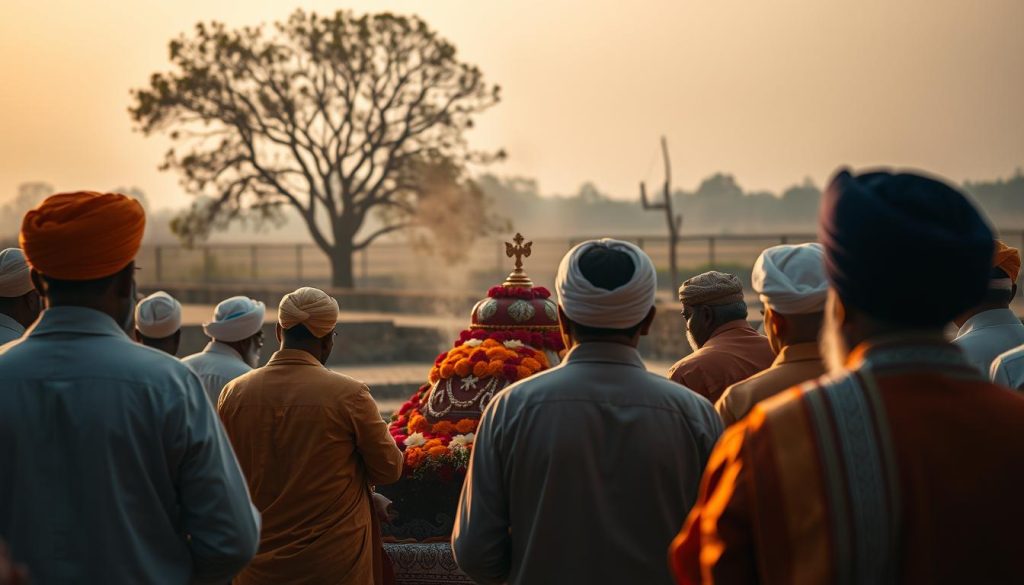
Common Practices and Beliefs
Hindu and Sikh funeral customs have both similarities and differences. Hindus perform the Antyeshti Sanskar very quickly after death. This makes respectful behaviour at these funerals very important. Mourning can last from 10 to 30 days, ending with the Kriya ceremony.
Sikhs usually have a shorter mourning time, with funerals within ten days. In both religions, wearing modest, light-coloured clothes is required. White stands for purity and respect. Putting ashes in holy rivers means setting the soul free. It shows their belief in life after death and remembering the divine.
In places like the UK, we should know different mourning times and funeral customs. This ensures respect at Hindu and Sikh funerals. These traditions comfort the bereaved and celebrate lasting spiritual beliefs.
Sikh Funeral Rituals and Customs
Sikh funerals show deep respect for the dead and their community. They include customs to honour the soul. They also support the grieving family with prayers and activities. Knowing these customs helps one participate with respect.
Preparation and Washing of the Body
The first step involves washing and preparing the body, called 'Ishnan'. It's a way to cleanse and ready the deceased for their final journey. The body is then dressed in clean clothes. It's adorned with five articles of faith, known as 'kakars'. These are Kesh (unshorn hair), Kangha (wooden comb), Kachha (cotton undergarment), Kara (steel bracelet), and Kirpan (small sword).
Day of the Funeral
The funeral service, called 'Antam Sanskaar', happens within three days of death. It includes readings from Sikh scriptures, mainly the Guru Granth Sahib. Sikhs prefer cremation, which usually follows the service. Family and friends can say goodbye, as open caskets are allowed. The service lasts about 30 to 60 minutes.
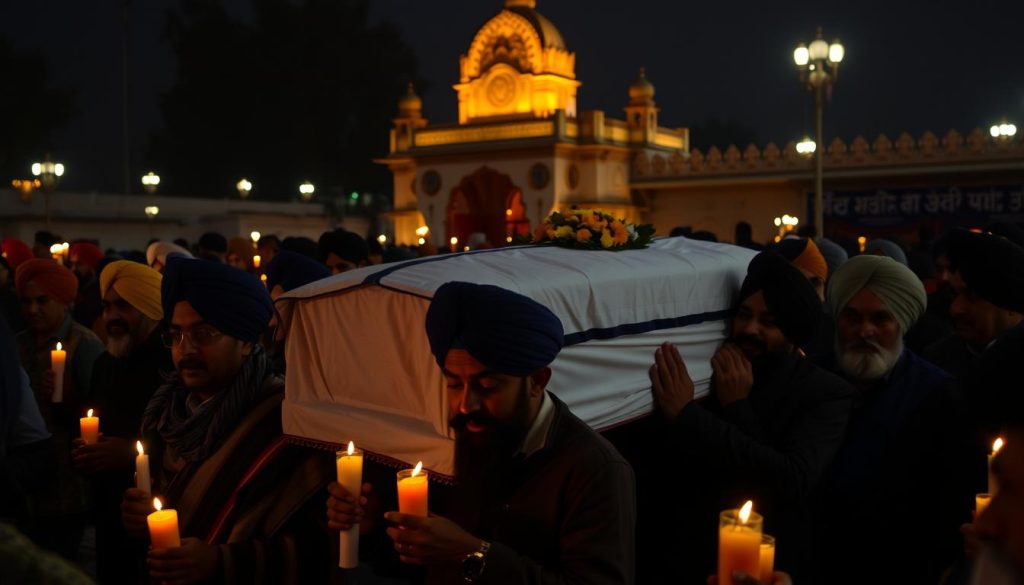
Post-Funeral Practices
After the funeral, supporting the bereaved family is key. One important ritual is the 'Akhand Paath'. This is a non-stop reading of the Sri Guru Granth Sahib for three days or sometimes ten days. During this time, family and friends gather. They offer prayers ('Ardas') and hymns together, instead of showing grief openly. Vegetarian meals are shared, and flowers, often orange and white chrysanthemums, are used.
The ashes are usually placed in a river, showing a return to nature. The mourning lasts a few weeks. The family may go to more prayer services at the gurdwara. This ensures they feel supported by their community.
Hindu Funeral Rituals and Customs
Hindu funeral customs are full of deep spiritual meaning. They offer comfort to families in grief. The ceremonies from start to end show respect for the dead.
Initial Ceremonies and Body Preparation
Right after death, the dead person is prepared with care. They are dressed in white to show purity, except for some specific cases. Flowers, sandalwood, and garlands decorate the body. This shows the sacred journey of life.
Cremation versus Burial
Cremation is most common in Hindu rituals. It is believed to free the soul. The eldest son has a special role in lighting the pyre. This shows the family's duty and life's cycle. In other countries, these rituals happen in crematoriums. Burial is rare and mainly for babies or saints.
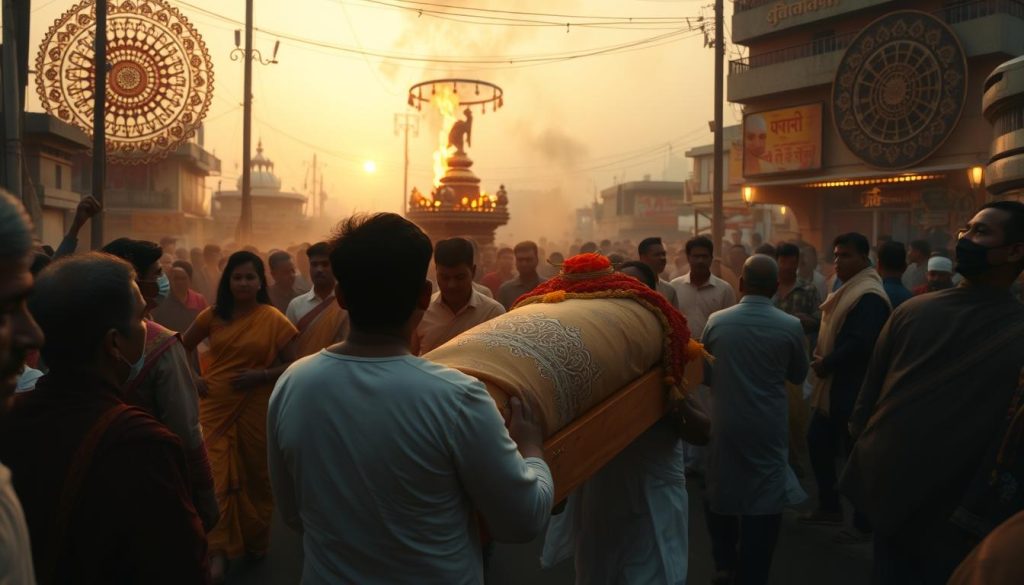
Mourning Period and Final Rituals
The mourning lasts for thirteen days after cremation. It includes rituals to help the soul find peace. The Shraddha ceremony lets the family offer food and prayers. It marks the soul's journey and brings the family peace. The Tarpan ritual highlights the importance of ancestors.
The belief in reincarnation makes death a hopeful next step, not the end.
Going to Hindu funerals helps us understand and connect with these traditions. It shows our support for those who are mourning.
Understanding Proper Behaviour at Hindu Funerals
Knowing how to act at Hindu and Sikh funerals is key. It shows respect to the grieving family. There are important rules to follow at Hindu funerals:
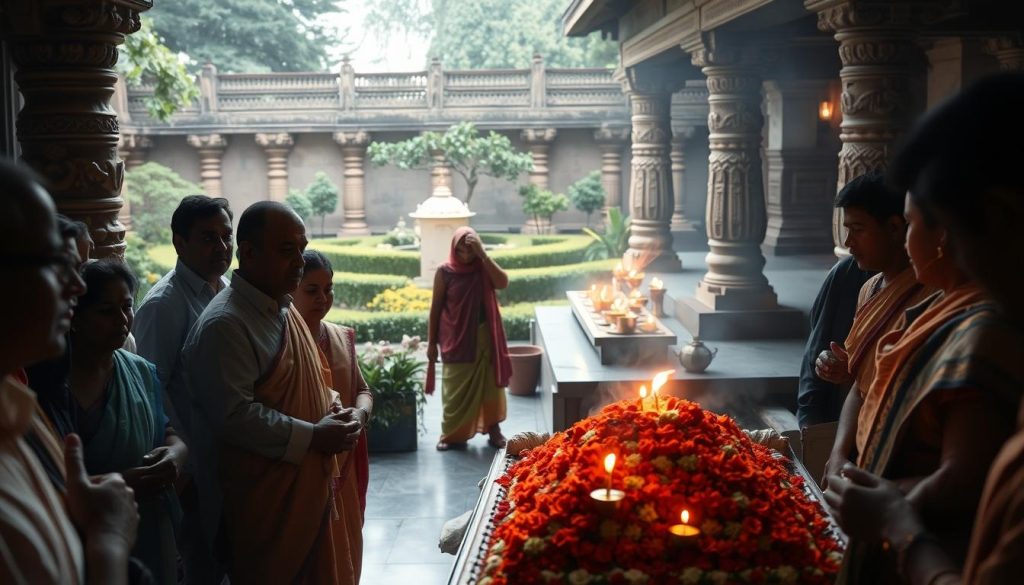
What you wear is very important. People wear white to show purity and grief. This is different from the West where black is worn. You should wear white or light, soft colours. Clothes should cover your arms and legs. You can wear open-toe shoes but take them off before going into the venue.
The dead person is usually burned within a day of passing. Before this, you can see them to say goodbye. The oldest son often leads the funeral. They read from holy books. This is because they believe death starts a new chapter, not the end.
For 13 days, the family wears white and doesn’t eat meat or shave. They keep to themselves. On day 14, they do a special ceremony to end this period. They also have ceremonies to remember their ancestors on certain days after the death.
| Aspect | Details |
|---|---|
| Cremation Timing | Within 24 hours of death |
| Mourning Period | 13 days |
| Antyeshti Ceremony | 14th day after death |
| Dress Code | White or light, subdued colours, modest attire |
| Food Restrictions | Abstain from meat |
| Ancestors Honour | Shraddha on 1st, 3rd, 5th, 7th, or 11th day |
| Ashes Immersion | 10th, 12th, or 13th day after death |
At Hindu and Sikh funerals, joining in rituals and saying sorry is important. If you know the prayers, you can say them with others. Letting the family know you’re sorry for their loss is key. It’s good to support them during this hard time.
Considering Appropriate Conduct at Sikh Funerals
Attending a Sikh funeral means knowing how to act. It's crucial to understand what to do and what not to do. Sikhism values community, rituals, and helping those who lost someone.
Proper Attire and Customs
At a Sikh funeral, dress simple and respectful. Both men and women should cover their heads with a scarf or turban. Choose white or soft colours and avoid bright ones. Always take off your shoes in the Gurdwara.
Learning funeral customs is key. Guests quietly join in prayers. This shows deep respect. It also brings comfort to those who are grieving.
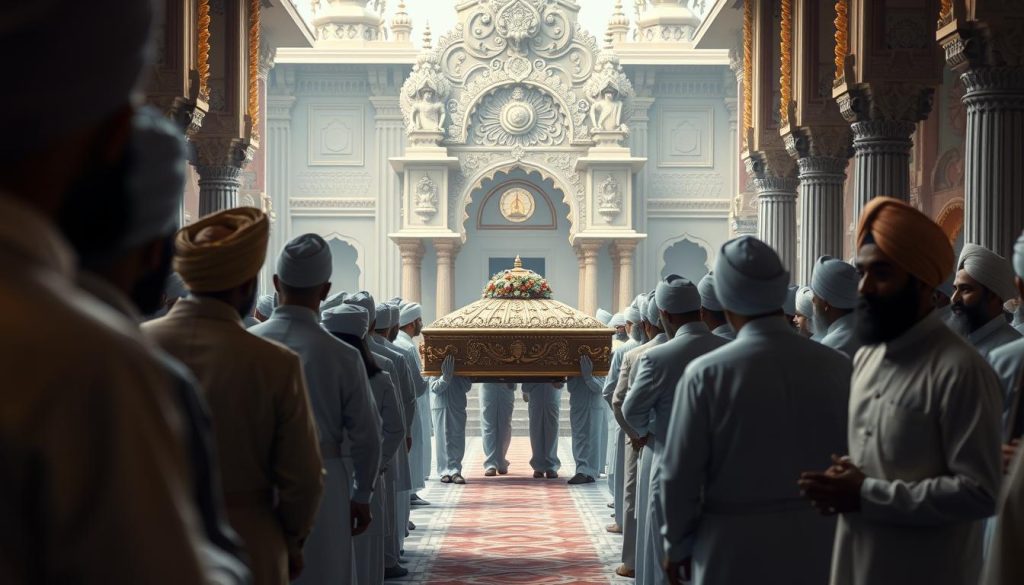
Supporting the Family
Help the family however you can during this tough time. Being there shows you care. Helping out with everyday tasks can really support them.
Knowing how to offer comfort is part of the funeral. Attending the bhog ceremony is also important. It marks the mourning's end and supports the family emotionally.
Dressing and Attending: What to Wear
When you go to a funeral, it is a way to show you care and respect. What you wear is very important. It shows honour to the person who has died and their family. Dressing guidelines for Hindu and Sikh funerals help us show respect properly. We will look into what to wear at these traditional dress codes at funeral ceremonies.
Traditional Dress Codes for Hindu Funerals
At Hindu funerals, people believe in showing purity and respect by keeping it simple. White is the main colour because it stands for mourning. Women should wear something simple like a salwar kameez or saree. These clothes should be modest and not too flashy or colourful. Men wear a plain white kurta and pajama.
Being comfortable is important, as you might have to sit on the floor. You should also cover your head. Women can use a scarf, and men might wear a cap or turban. Following these dress rules shows deep respect for the ceremony.
Appropriate Attire for Sikh Funerals
The Sikh funeral, or Antam Sanskaar, has special customs about what to wear. White is also the mourning colour here, showing respect for the person who has died. Yet, wearing soft, dark colours like black, navy, and grey is okay too.
Avoiding bright colours, especially red, is important because it's seen as disrespectful. Women could wear a simple salwar kameez or a modest blouse with a long skirt. Men should wear a smart, dark suit with a white shirt. Polished black shoes make the outfit look respectful.
By following the dressing guidelines for Hindu and Sikh funerals, we show we care. It helps support the family who has lost someone special.
Keeping Cultural Sensitivity in Mind
Understanding different funeral customs shows respect at funerals. Each culture honours the dead in unique, meaningful ways. In places like Singapore, these practices show the richness of traditions.
For example, Jain funerals often feature songs and prayers and last about an hour. People wear white, showing respect and purity. The eldest son usually leads eco-friendly burials quickly after death. This shows Jains' deep respect for nature.
In Singapore, Muslim Malays have burials soon after death. Hindu funerals have special rituals and cremations. The Chinese hold ceremonies with chanting and incense. All these practices show Singapore's diverse beliefs.
In Northern Ireland, laws like the Race Relations (NI) Order promote cultural sensitivity. They make sure services consider everyone's background. The Children (NI) Order makes sure childcare respects a child's culture.
Doctors are urged to consider patients' faiths in their care plans. This can really help patients feel understood. Laws also say interpreters must be used in healthcare, so everyone gets clear, respectful care.
So, being culturally sensitive at funerals and elsewhere makes our world kinder and more respectful. It helps us value and celebrate what makes each culture special.
Key Differences Between Hindu and Sikh Funeral Etiquette
It's important to know how Hindu and Sikh funerals differ. Each has unique rituals tied to their beliefs. These traditions show their spiritual views and cultural values.
Ritual Practices
Hindu funerals follow a set order. The body is cleaned, dressed in simple clothes, and then taken to be cremated. The eldest son or a close male family member lights the pyre. This act signals the soul's final leave-taking from this world.
Sikh funerals are different. The body is washed with yogurt and soap, and then put in white clothes. A final prayer, the Antim Ardaas, is very important. It shows the community praying for the soul that has passed. Most Sikh families prefer cremation, and many take part in lighting the pyre. This highlights their belief in the soul's eternal journey after death.
Mourning and Support Customs
Hindu and Sikh mourning customs vary. Hindus have a 13-day intense mourning with rituals. The main mourner, usually the eldest son, might shave their head. Mourning can last a year for close family, limiting social activities.
Sikhs have a 10-day mourning called Nihung. They also read the Guru Granth Sahib over several days in the Sahaj Paath Bhog. This shows the power of community support in tough times. After both funerals, communal meals help families and friends bond.
Understanding these funeral customs helps us support and respect grieving families properly. It lets us honor the memory of those who have passed.
Conclusion
Hindu and Sikh funeral customs show deep respect for those who have passed away. These traditions help support families when they are sad. It's important to truly understand and follow these customs.
Sikh funerals happen within three days and include rituals like washing the body. There are also prayer sessions and scattering ashes in water. The 'Barsi' event is held on the first anniversary to remember the loved one.
Hindu funerals have special ceremonies too. They include giving fruit, rice, and incense to the deceased. These rituals help express shared feelings of sadness and respect.
Being respectful at these funerals means understanding the culture. Whether it's a Sikh or Hindu service, wear the right clothes and join in the customs. This shows deep care and unity. Knowing about these traditions helps us support our communities during tough times.
FAQ
What is the cultural significance of Hindu and Sikh funeral traditions?
These rituals are very important in both religions. They show their views on life, death, and what comes after. They help to honor those who have passed away. They also help the family feel better through set customs and ceremonies.
What are the common practices and beliefs shared by Hindu and Sikh communities regarding funerals?
Both groups stress showing respect for those who have died. They also believe in helping the family that is grieving. Rituals often have prayers, scripture readings, and preparing the body in special ways.
How is the body prepared in Sikh funeral rituals?
The body is washed and made ready in a special ceremony. This shows a deep respect for the person who has died. Close family or certain people in the community do this task.
What happens on the day of a Sikh funeral?
The funeral has readings from Sikh holy books. It ends with special rites at a crematorium. People come together to say sorry for the loss. They join in prayers too.
What are the post-funeral practices in Sikhism?
After the funeral, there are prayers and meals with others. This shows the community's support for the grieving family. It helps them during their sad time and respects Sikh beliefs about the soul's journey.
What initial ceremonies are performed in Hindu funerals?
Initial ceremonies begin straight after death. The body is cleaned, dressed, and sometimes oiled. Family or priests often do this.
How do Hindu families decide between cremation and burial?
The choice is usually based on family and local traditions. Cremation is more usual. It is seen as freeing the soul from the body.
What does the mourning period look like in Hindu funeral customs?
The mourning time has many ceremonies. They include Shraddha to give closure and respect the soul's journey. This time can be a few days to several weeks, based on family habits.
How should one behave at a Hindu funeral to show proper respect?
Guests should wear simple, white clothes and join in rituals respectfully. Saying sorry in a humble way and being quiet are important too.
What is considered appropriate conduct at Sikh funerals?
Dress modestly and cover your head, no matter if you are a man or woman. Respect the rituals. Support the family that is grieving.
What should one wear to a Hindu funeral?
Dress in white to show purity and mourning. Choose simple clothes that show respect for the serious time.
What is the appropriate attire for Sikh funerals?
Dress modestly. Cover your head. Men might wear turbans or caps. Women use scarves for their heads.
Why is cultural sensitivity important at Hindu and Sikh funerals?
It’s crucial to respect and understand different practices and beliefs. This shows care for the grieving family. It helps avoid accidentally upsetting anyone.
How do Hindu and Sikh funeral etiquettes differ?
They differ in their rituals and how they mourn. Hindu funerals have many rituals after death. Sikh funerals focus on prayers with others and meals to help the family feel supported.

